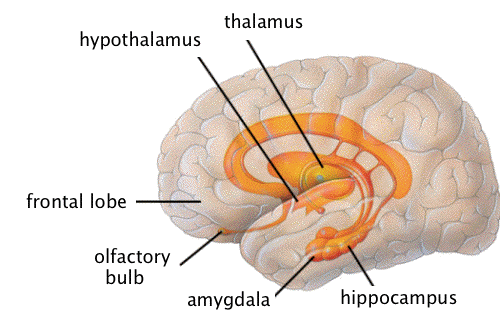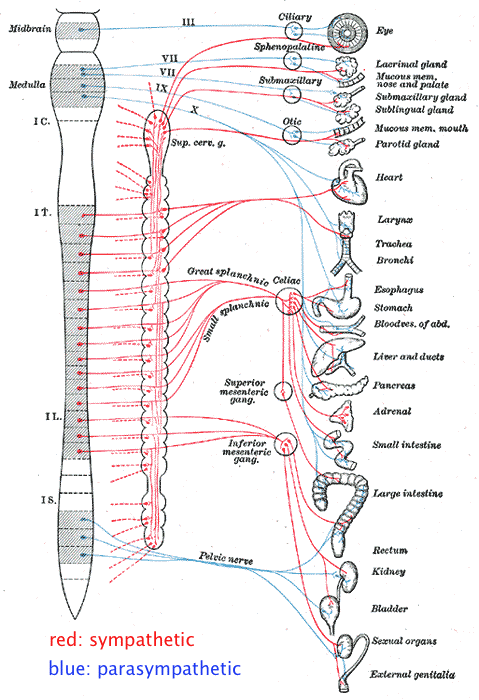The Emotional Nervous System
Dr. C. George Boeree
The Emotional Nervous System
Dr. C. George Boeree
Emotion involves the entire nervous system, of course. But there are two parts of the nervous system that are especially significant: The limbic system and the autonomic nervous system.
The Limbic System
The limbic system is a complex set of structures that lies on both
sides of the thalamus, just under the cerebrum. It
includes the
hypothalamus, the hippocampus, the amygdala, and several other nearby
areas.
It appears to be primarily responsible for our emotional life, and has
a lot to do with the formation of memories. In this drawing, you
are looking at the brain cut in half, but with the brain stem
intact. The part of the limbic system shown is that which is
along the left side of the thalamus (hippocampus and amygdala) and just
under the front of the thalamus (hypothalamus):

Hypothalamus
The hypothalamus is a small part of the brain located just below the thalamus on both sides of the third ventricle. (The ventricles are areas within the cerebrum that are filled with cerebrospinal fluid, and connect to the fluid in the spine.) It sits just inside the two tracts of the optic nerve, and just above (and intimately connected with) the pituitary gland.
The hypothalamus is one of the busiest parts of the brain, and is mainly concerned with homeostasis. Homeostasis is the process of returning something to some “set point.” It works like a thermostat: When your room gets too cold, the thermostat conveys that information to the furnace and turns it on. As your room warms up and the temperature gets beyond a certain point, it sends a signal that tells the furnace to turn off.
The hypothalamus is responsible for regulating your hunger, thirst, response to pain, levels of pleasure, sexual satisfaction, anger and aggressive behavior, and more. It also regulates the functioning of the autonomic nervous system (see below), which in turn means it regulates things like pulse, blood pressure, breathing, and arousal in response to emotional circumstances.
The hypothalamus receives inputs from a number of sources. From the vagus nerve, it gets information about blood pressure and the distension of the gut (that is, how full your stomach is). From the reticular formation in the brainstem, it gets information about skin temperature. From the optic nerve, it gets information about light and darkness. From unusual neurons lining the ventricles, it gets information about the contents of the cerebrospinal fluid, including toxins that lead to vomiting. And from the other parts of the limbic system and the olfactory (smell) nerves, it gets information that helps regulate eating and sexuality. The hypothalamus also has some receptors of its own, that provide information about ion balance and temperature of the blood.
In one of the more recent discoveries, it seems that there is a protein called leptin which is released by fat cells when we overeat. The hypothalamus apparently senses the levels of leptin in the bloodstream and responds by decreasing appetite. It would seem that some people have a mutation in a gene which produces leptin, and their bodies can’t tell the hypothalamus that they have had enough to eat. However, many overweight people do not have this mutation, so there is still a lot of research to do!
The hypothalamus sends instructions to the rest of the body in two ways. The first is to the autonomic nervous system. This allows the hypothalamus to have ultimate control of things like blood pressure, heartrate, breathing, digestion, sweating, and all the sympathetic and parasympathetic functions.
The other way the hypothalamus controls things is via the pituitary gland. It is neurally and chemically connected to the pituitary, which in turn pumps hormones called releasing factors into the bloodstream. As you know, the pituitary is the so-called “master gland,” and these hormones are vitally important in regulating growth and metabolism.
Hippocampus
The hippocampus consists of two “horns” that curve back from the
amygdala. It appears to be very
important
in converting things that are “in your mind” at the moment (in
short-term
memory) into things that you will remember for the long run (long-term
memory). If the hippocampus is damaged, a person cannot build new
memories, and lives instead in a strange world where everything they
experience
just fades away, even while older memories from the time before the
damage
are untouched! This very unfortunate situation is fairly
accurately
portrayed in the wonderful movie Memento, as well as in a more
light-hearted movie, 50 First Dates.
But
there
is nothing light-hearted about it: Most people who
suffer from this kind of brain damage end up institutionalized.
Amygdala
The amygdalas are two almond-shaped masses of neurons on either side of the thalamus at the lower end of the hippocampus. When it is stimulated electrically, animals respond with aggression. And if the amygdala is removed, animals get very tame and no longer respond to things that would have caused rage before. But there is more to it than just anger: When removed, animals also become indifferent to stimuli that would have otherwise have caused fear and even sexual responses.
Related areas
Besides the hypothalamus, hippocampus, and amygdala, there are other areas in the structures near to the limbic system that are intimately connected to it:
The cingulate gyrus is the part of the cerebrum that lies closest to the limbic system, just above the corpus collosum. It provides a pathway from the thalamus to the hippocampus, seems to be responsible for focusing attention on emotionally significant events, and for associating memories to smells and to pain.
The ventral tegmental area of the
brain stem (just below the
thalamus) consists of dopamine pathways that seem to be responsible for
pleasure. People with damage here tend to have difficulty getting
pleasure in life, and often turn to alcohol, drugs, sweets, and
gambling.
The basal
ganglia (including the caudate nucleus, the putamen, the globus
pallidus, and the substantia nigra) lie over and to the sides of the
limbic system, and are tightly connected with the cortex above
them. They are responsible for repetitive behaviors, reward
experiences, and focusing attention. If you are interested in
learning more about the basal ganglia, click
here.
The prefrontal cortex, which is the part of the frontal lobe which lies in front of the motor area, is also closely linked to the limbic system. Besides apparently being involved in thinking about the future, making plans, and taking action, it also appears to be involved in the same dopamine pathways as the ventral tegmental area, and plays a part in pleasure and addiction.
The Autonomic Nervous System
The second part of the nervous system to have a particularly
powerful
part to play in our emotional life is the autonomic nervous
system.
The autonomic nervous system is composed of two parts, which function
primarily
in opposition to each other. The first is the sympathetic
nervous
system, which starts in the spinal cord and travels to a variety of
areas of the body. Its function appears to be preparing the body
for the kinds of vigorous activities associated with “fight or flight,”
that is, with running from danger or with preparing for violence.

Activation of the sympathetic nervous system has the following effects:
dilates the pupilsOne of its most important effects is causing the adrenal glands (which sit on top of the kidneys) to release epinephrine (aka adrenalin) into the blood stream. Epinephrine is a powerful hormone that causes various parts of the body to respond in much the same way as the sympathetic nervous system. Being in the blood stream, it takes a bit longer to stop its effects. This is why, when you get upset, it sometimes takes a while before you can calm yourself down again!
opens the eyelids
stimulates the sweat glands
dilates the blood vessels in large muscles
constricts the blood vessels in the rest of the body
increases the heart rate
opens up the bronchial tubes of the lungs
inhibits the secretions in the digestive system
The sympathetic nervous system also takes in information, mostly concerning pain from internal organs. Because the nerves that carry information about organ pain often travel along the same paths that carry information about pain from more surface areas of the body, the information sometimes get confused. This is called referred pain, and the best known example is the pain some people feel in the left shoulder and arm when they are having a heart attack.
The other part of the autonomic nervous system is called the parasympathetic nervous system. It has its roots in the brainstem and in the spinal cord of the lower back. Its function is to bring the body back from the emergency status that the sympathetic nervous system puts it into.
Some of the details of parasympathetic arousal include...
pupil constrictionThe parasympathetic nervous system also has some sensory abilities: It receives information about blood pressure, levels of carbon dioxide in the blood, and so on.
activation of the salivary glands
stimulating the secretions of the stomach
stimulating the activity of the intestines
stimulating secretions in the lungs
constricting the bronchial tubes
decreasing heart rate
There is actually one more part of the autonomic nervous system that
we don't mention too often: The enteric nervous system.
This
is
a complex of nerves that regulate the activity of the
stomach.
When you get sick to your stomach or feel butterflies when you get
nervous,
you can blame the enteric nervous system.
© Copyright 2002, 2009, C. George Boeree